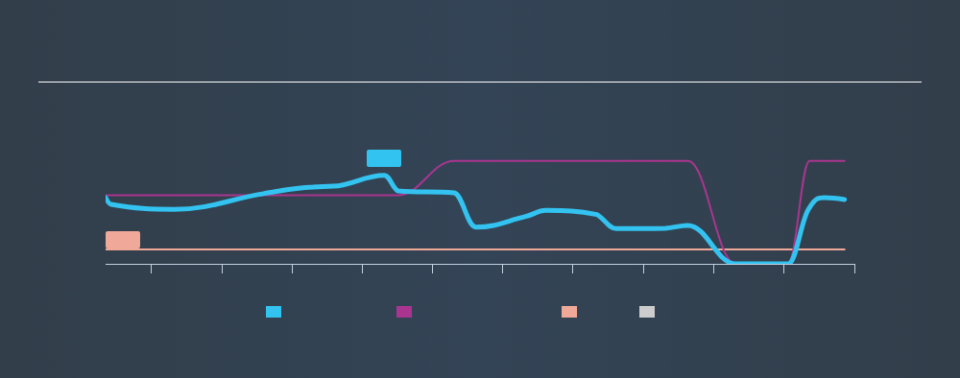Read This Before Buying Aro Granite Industries Limited (NSE:AROGRANITE) For Its Dividend

Today we'll take a closer look at Aro Granite Industries Limited (NSE:AROGRANITE) from a dividend investor's perspective. Owning a strong business and reinvesting the dividends is widely seen as an attractive way of growing your wealth. If you are hoping to live on your dividends, it's important to be more stringent with your investments than the average punter. Regular readers know we like to apply the same approach to each dividend stock, and we hope you'll find our analysis useful.
A 2.5% yield is nothing to get excited about, but investors probably think the long payment history suggests Aro Granite Industries has some staying power. Some simple analysis can reduce the risk of holding Aro Granite Industries for its dividend, and we'll focus on the most important aspects below.
Explore this interactive chart for our latest analysis on Aro Granite Industries!
Payout ratios
Dividends are usually paid out of company earnings. If a company is paying more than it earns, then the dividend might become unsustainable - hardly an ideal situation. So we need to form a view on if a company's dividend is sustainable, relative to its net profit after tax. Aro Granite Industries paid out 15% of its profit as dividends, over the trailing twelve month period. Given the low payout ratio, it is hard to envision the dividend coming under threat, barring a catastrophe.
Is Aro Granite Industries's Balance Sheet Risky?
As Aro Granite Industries has a meaningful amount of debt, we need to check its balance sheet to see if the company might have debt risks. A quick check of its financial situation can be done with two ratios: net debt divided by EBITDA (earnings before interest, tax, depreciation and amortisation), and net interest cover. Net debt to EBITDA measures total debt load relative to company earnings (lower = less debt), while net interest cover measures the ability to pay interest on the debt (higher = greater ability to pay interest costs). With net debt of 5.42 times its EBITDA, Aro Granite Industries could be described as a highly leveraged company. While some companies can handle this level of leverage, we'd be concerned about the dividend sustainability if there was any risk of an earnings downturn.
We calculated its interest cover by measuring its earnings before interest and tax (EBIT), and dividing this by the company's net interest expense. Net interest cover of 5.17 times its interest expense appears reasonable for Aro Granite Industries, although we're conscious that even high interest cover doesn't make a company bulletproof. Adequate interest cover may make the debt look safe, relative to companies with a lower interest cover ratio. However with such a large mountain of debt overall, we're cautious of what could happen if interest rates rise.
We update our data on Aro Granite Industries every 24 hours, so you can always get our latest analysis of its financial health, here.
Dividend Volatility
Before buying a stock for its income, we want to see if the dividends have been stable in the past, and if the company has a track record of maintaining its dividend. For the purpose of this article, we only scrutinise the last decade of Aro Granite Industries's dividend payments. The dividend has been cut by more than 20% on at least one occasion historically. During the past ten-year period, the first annual payment was ₹0.67 in 2009, compared to ₹1.00 last year. This works out to be a compound annual growth rate (CAGR) of approximately 4.1% a year over that time. The dividends haven't grown at precisely 4.1% every year, but this is a useful way to average out the historical rate of growth.
It's good to see some dividend growth, but the dividend has been cut at least once, and the size of the cut would eliminate most of the growth, anyway. We're not that enthused by this.
Dividend Growth Potential
With a relatively unstable dividend, it's even more important to see if earnings per share (EPS) are growing. Why take the risk of a dividend getting cut, unless there's a good chance of bigger dividends in future? Over the past five years, it looks as though Aro Granite Industries's EPS have declined at around 19% a year. A sharp decline in earnings per share is not great from from a dividend perspective, as even conservative payout ratios can come under pressure if earnings fall far enough.
Conclusion
Dividend investors should always want to know if a) a company's dividends are affordable, b) if there is a track record of consistent payments, and c) if the dividend is capable of growing. We're glad to see Aro Granite Industries has a low payout ratio, as this suggests earnings are being reinvested in the business. Earnings per share are down, and Aro Granite Industries's dividend has been cut at least once in the past, which is disappointing. Aro Granite Industries might not be a bad business, but it doesn't show all of the characteristics we look for in a dividend stock.
You can also discover whether shareholders are aligned with insider interests by checking our visualisation of insider shareholdings and trades in Aro Granite Industries stock.
If you are a dividend investor, you might also want to look at our curated list of dividend stocks yielding above 3%.
We aim to bring you long-term focused research analysis driven by fundamental data. Note that our analysis may not factor in the latest price-sensitive company announcements or qualitative material.
If you spot an error that warrants correction, please contact the editor at editorial-team@simplywallst.com. This article by Simply Wall St is general in nature. It does not constitute a recommendation to buy or sell any stock, and does not take account of your objectives, or your financial situation. Simply Wall St has no position in the stocks mentioned. Thank you for reading.

